The SilverStone Fortress FT05 Case Review
by E. Fylladitakis on June 5, 2015 8:00 AM EST- Posted in
- Cases/Cooling/PSUs
- SilverStone
- Case
The Interior of the SilverStone Fortress FT05
Latches hold the side panels in place and simply pressing on them and pulling the panel upwards is enough to remove it, as there are no screws involved. Both side panels feature a layer of sound absorbing material. A little force may be necessary to move the panels though, due to the fact that the insulation on the side panels acts as a sealant between the panel and the chassis, creating significant friction during removal.
Once the side panels are off, the miniscule internal volume of the Fortress FT05 becomes apparent. With a large area at the top of the case reserved for the routing of cables and another area at the bottom reserved as an air intake, the interior is barely larger than the motherboard tray itself. Everything inside the case is black, including the plastic drive cage, the fans and the cables. The motherboard tray is rotated by 90°, with the rear of the motherboard facing straight up. There are numerous openings, a large one for the installation of CPU coolers and several small ones for the routing of cables. No openings have rubber grommets. Mechanically, the strength of the Fortress FT05 is exceptional, with no apparent flex. This was no surprise, considering the small dimensions and extensive use of metallic materials.
There are two plastic arches at the top of the case, above the motherboard tray. Their primary task is to be used as guides for the cables but they are very sturdy and can easily hold the weight of the case, so they can be used as handles as well. In order to reach some screws, the screwdriver needs to go through the holes of these arches. A screwdriver with an 100mm long shank will suffice but thick shanks (e.g. insulated screwdrivers, bit extension rods, etc.) may not fit through the arch hole.
Much as with the Raven RV05, the Fortress FT05 has two 180mm SST-AP181-H fans preinstalled at the bottom of the internal area. Due to their wing size, the CFM rating of these fans is 130CFM, an absurd figure considering that they can only reach a maximum speed of 1200RPM. However, this is their maximum CFM rating, which means that the fans need to be completely unobstructed and operating under specific environmental conditions. Inside the case and behind a filter, the actual air delivery will not be half as much. The dense spiraling finger guard will reduce the actual airflow even further but it is very practical inside the Fortress FT05, as a large number of cables will surely be routed right above the fans.
In order to install a 240mm or 280mm liquid cooling radiator, these fans need to be removed. However, it might not be a good idea, as the airflow will be greatly reduced and the temperature of the air intake will be increased. This could work in systems where the only major thermal load is the CPU but it could create more problems than it would solve if there are powerful GPUs or a stressed/overclocked motherboard installed. A smaller radiator (up to 120mm and thin) may fit at the smaller opening at the top of the case, but the proximity of the motherboard can create compatibility issues.
The Fortress FT05 can hold only two 3.5" devices, in a plastic cage located at the rear of the system. Simply sliding the two 3.5" drives into the cage works, but there are screw holes for a more secure installation as well. If no 3.5" drives are present, the cage can be removed to increase the internal volume of the case and to enlarge the clearance of the PSU.
There is a little extra space at the rear of the motherboard tray reserved for two 2.5" devices and for the routing of cables. If both 2.5" devices are installed, there is very little space left for cables. With virtually no clearance between the drives and the side panel, the routing of the cables becomes a small nightmare. The plastic compartment to the left of the motherboard tray is for the slim slot-loading drive, should the user decides to install one. It will have to be removed if a CPU cooler needs to be installed with the motherboard inside the case.
The PSU compartment is at the upper rear side of the case and the PSU is installed with its exhaust facing upwards. PSUs up to 170mm long may fit, limiting the possible choices to low and medium power models, but these ought to be more than sufficient for the systems that can painlessly fit inside the Fortress FT05. Since the space is very limiting, we initially tried to install a SilverStone SX600-G, a 600W SFX modular PSU. It comes with an ATX adapter and it seemed like a good choice for such a case, but the cables of the PSU were far too short to be of use, as the distance between the PSU area and across the length of an ATX motherboard proved too great. We installed the usual PSU that we are using for our case reviews instead, the Corsair AX760i with the red cable set, for visual contrast. The PSU fit very tightly and it is all but impossible to install/remove modular cables once the PSU is in. We strongly recommend using a PSU up to 150-155mm long maximum with the Fortress FT05. SilverStone's Strider Gold S 550W and 650W units are just 140mm long and should be a very good fit.
Even with just one GPU installed, the interior of the Fortress FT05 appears overly tight and cramped. There are very few cable pathways and most are bound to be routed right in front of the intake fans. There is also no opening for the CPU power cable (or, to be exact, the opening is far too small) and the cable needs to go across the motherboard in order to reach the connector. Graphics cards up to 310mm can fit, which covers most cards but rules very high performance models and dual GPU implementations, which are not exactly intended to be installed in such a confined case. Multiple graphics cards can also be installed but it is no coincidence that only a single larger opening for the PCI Express power cables exists. This case is not intended to be used as the home of a multi-GPU gaming monster, it has been primarily designed to hold a normal ATX motherboard and up to a single good graphics card.
The routing of the cables from the rear of the motherboard tray is difficult, as there is very little space when even a single 2.5" drive has been installed. There is also the possibility of damaged cables from the sharp edges of the motherboard tray, so bundling the cables and then pressing the side panel hard until it closes is not a particularly wise idea.


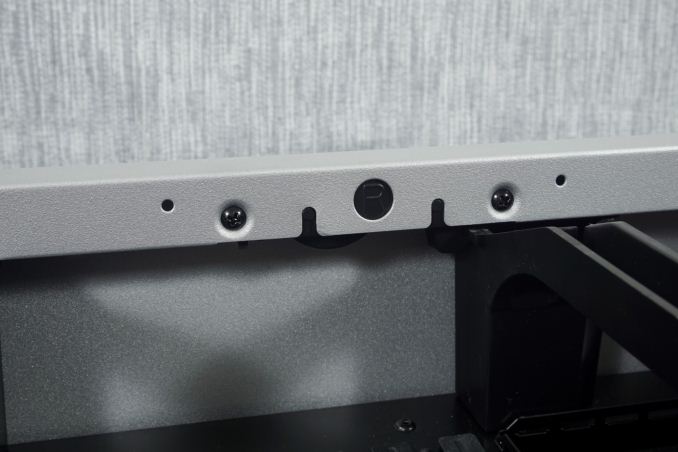
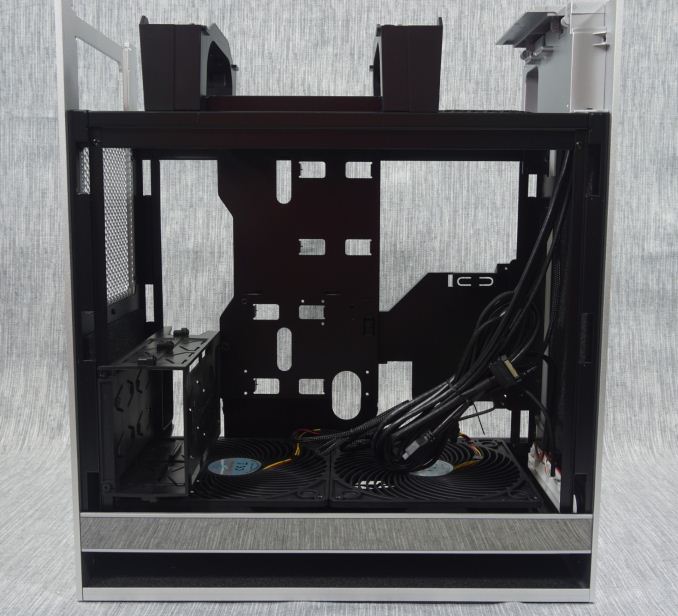
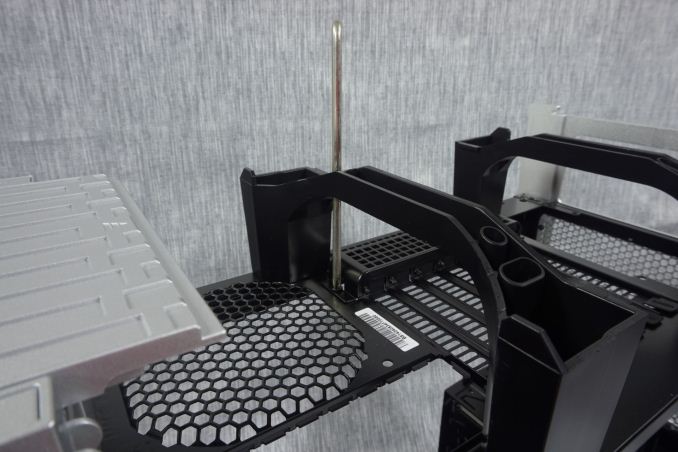

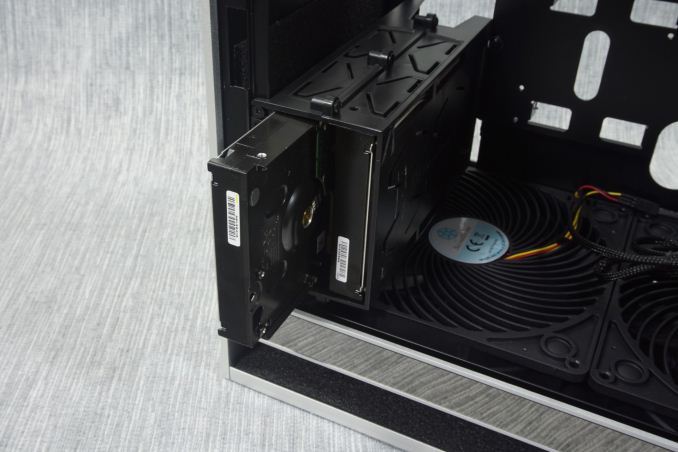
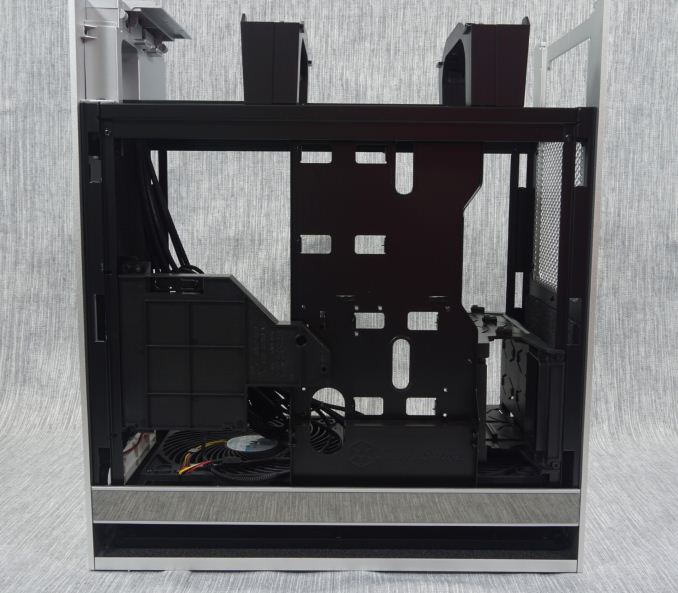
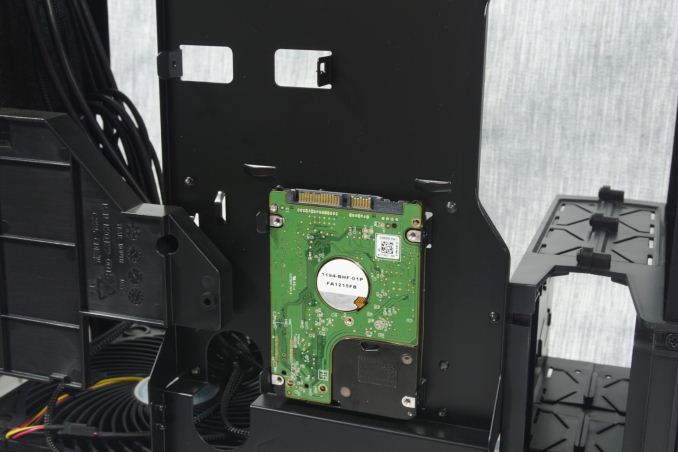
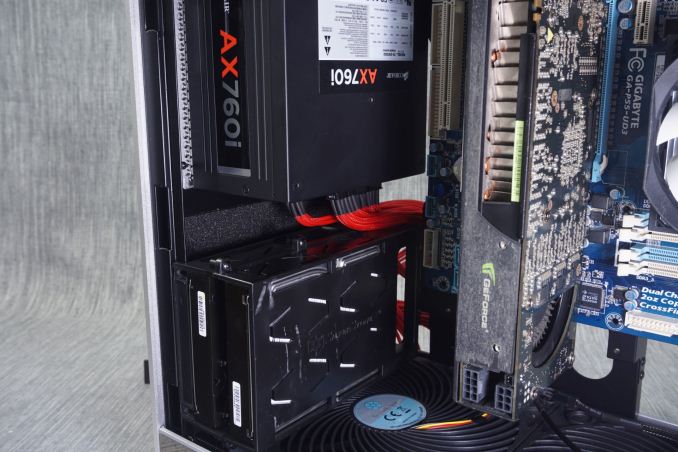









47 Comments
View All Comments
E.Fyll - Friday, June 5, 2015 - link
I will try to be as succinct as possible.Taking a lot of time to make a case look tidy is, simply put, not good.
As pictured, the cables of the AX760i are hard pressed against the HDD cage. You cannot insert or remove any cables. Having to take out the entire HDD cage to insert a cable is, simply put, not good.
It is not my job to spend a lot of time to try and hide the cables. Given enough time and resources, I can hide every single cable inside the smallest ITX case. If I need a lot of time to route and hide cables, that is -1 for any design. If you cannot hide the cables altogether with a design forcing you to run them across the motherboard, like this one, that's -3. Or -50. Depends on how biased towards tidiness you are.
My opinion could be "skewed" but pictures tell no lies. Judge for yourselves.
Isn't it rather ironic that whenever I say something positive about a product I am "on the take" and whenever I say something negative my opinion is "skewed"? :P
wurizen - Friday, June 5, 2015 - link
Hi,First of all, thanks for replying. I assume you are the reviewer of this case. Any one can make things look tidy given enough time. But, it also doesn't take up that much time after some thought have been made to where to route the cables for this case. The fact that you went about your cabling in the same way as you would go about routing cables for a case that is much bigger is... as you put it... NOT GOOD. Just because there aren't any grommet holes or dedicated spots for cables doesn't mean that there isn't a way for those cables to be placed there. For example, the 8-pin CPU cable needs to be tucked in under the mobo first, so it runs across the back of the case. This is one example of no grommets, but, yet, the 8-pin CPU cable can be placed on this case in the same manner as any case with special grommet or holes for them. This is because there is space on the right side of the case for the 8-pinCPU cable to snake through as well as all the system wires.
"My opinion could be "skewed" but pictures tell no lies. Judge for yourselves." If you look at that picture, I can see clearance and space for the cables to be taken out even without removing the HDD cage. I also know this because I have the AX760 and I've swapped cables without having to remove the cage. Is it tight? Yes. Is it impossible or that hard? No!
I am not biased about tidiness. But, you're a reviewer. People will look at this review and see how you run the cables and it's not how it's done. It's not just for aesthetics or some OCD for tidiness, either. But, if you leave the cables as pictured on your review, then you have all those system cables in front of the bottom fan impeding or blocking airflow. Thus, it is not just a tidy thing but also an ethical thing. You've "skewed" the thermal performance of the case by not routing the cables the correct way.
thank you!
I use to place this site as one of the better tech sites. But, no more!!!
Ryan Smith - Saturday, June 6, 2015 - link
wurizen, while I regret that we can't meet all of your standards, I do stand by my editor in the case of this case (er, no pun intended). Given the small space available in the FT05, E. did a reasonable job on cable routing. Especially since this is just for evaluating the build-friendliness of the case and taking pictures of what an assembled system will look like. There are tradeoffs to be had in terms of time, and even experienced builders are going to have trouble getting the "perfect" build on this case. E's build, I believe, is likely better than what the majority of users will accomplish with this case."Thus, it is not just a tidy thing but also an ethical thing. You've "skewed" the thermal performance of the case by not routing the cables the correct way."
I would also quickly note that we don't test this case with standard components (as installed), but rather with a dummy load. More details can be found on page 4. This admittedly creates a setup that's a bit idealized, but it also means that the results aren't being impacted by the build itself, since it's not present for testing. So I can assure you that the results are not negatively skewed.
vivi2000 - Friday, June 5, 2015 - link
The article states that the fan speed switches are only 2 way(low/high) but they are actually 3 way but only labeled as 2 way.romrunning - Friday, June 5, 2015 - link
E.Fyll - thanks for posting both metric & non-metric measurements for the case dimensions (H×W×D)!Impulses - Friday, June 5, 2015 - link
I think making it wider would've solved a lot of issues, they could've had more cable management room, space for a vertically mounted 5.25" bay, etc... I'll stick with my Corsair Air 540, of which I have the opposite complaint.I don't mind that the 540 is SO wide but it wastes a lot of space on the right compartment, should've had one more drive cage there or been narrower, at least it was cheap tho and the unobstructed airflow thru the left compartment probably works as well as Silverstone's bottom/top design.
I feel like there's plenty of room to innovate with designs like that tho, which don't force the typical and awkward S shaped airflow path and/or don't waste a ton of space up front on 5.25" bays.
deadlockedworld - Friday, June 5, 2015 - link
When I bought my FT02, it was because my wife insisted that I get something that wasn't too ugly and I needed it to run with very little front ventilation. Had this existed at that time I would have paid basically any amount of money for it. Value isn't even part of the equation!Few other manufacturers can make a case this classy looking, yet with good thermal performance. They are targeting a niche user, who cares about looks as much as performance and doesn't have financial constraints.
tim851 - Saturday, June 6, 2015 - link
>>> True enough, convective heat transfer suggests that higher temperature air will naturally flow>>> upwards, so the design does make sense. The case does act as a convective heater
I wish reviewers weren't parroting marketing speak all the time.
It's been shown time and again that convection plays no role in a case once forced air movement (aka: fans) come into play. The FT05 (or FT02 or any other of these) isn't such a great performer because "hot air rises", but because it employs two huge 180mm intake fans.
If you want to test this, just turn it on it's face, so that the airflow becomes horizontal, and marvel at how the temps don't change.
Valantar - Saturday, June 6, 2015 - link
Kind of a shame that this could have been a truly excellent case if only they had added 1-2 cm to its width and length for cable management. With space for cables along the "top" (i.e. right side) of the motherboard, they could have stuck a hdd/ssd mount or two along the side there too. Suddenly, the case would be both roomy and have plenty of expandability.MCX - Saturday, June 6, 2015 - link
Having had my fill of custom watercooling, I went back to Silverstone's Fortress series with the FT05, which seemed like a good successor to the FT02, making a reasonable compromise between size and flexibility. Like the FT02 the backside is unnecessarily cramped and not very useful for cable management, but also like the FT02, the thermal performance and noiseless operation is impressive.Besides the lack of neat cable management, a bit too much is made of how hard it is to build in the case. Sure, it's not for beginners, and if I were someone who changed components weekly or if I had to build hundreds of these, I'd acquiesce to a larger case, but for relatively experienced builders who isn't changing motherboards or cpus every other week, it's not a big deal.
Currently, I'm using it with a Noctua DH15 for my cpu and a semi-passive psu and a gpu (an AX860 and a Strix 970). Case fans are controlled by the motherboard. It allows for whisper-quiet computing that hardly gets louder while gaming, even with a reasonable overclock.